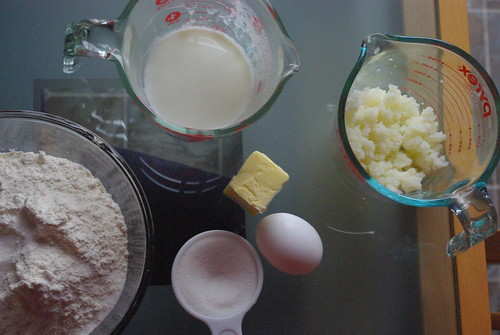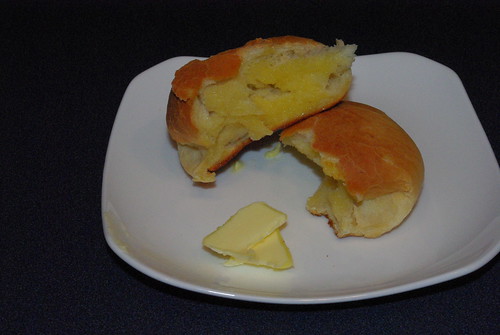Bake The Book: Old-Fashioned Dinner Rolls
I have an aunt who is known for her dinner rolls. I can only hope to be as seasoned as her someday at making these. For my first attempt, however, I was extremely happy with the result. Soft, warm, buttery goodness. I mean, how can you go wrong?
The key ingredient to old fashioned dinner rolls is a russet potato. Here it is all cooked and ready to mash.
What makes up the dinner roll dough, you ask? See below.
Here are the little buggers as they were put in the oven. I really need to work on my "shaping into balls" technique, but I'll get there.
And here is the finished product. These were so good, I personally don't even think you need the extra butter. 
These make a great side to almost any home cooked meal. And you can freeze them for up to 3 weeks after baked, so one could always make a batch ahead of time to have on hand for the next time guests are entertained!
Recipe #8: Old-Fashioned Dinner Rolls
Ingredients
1 small (5 ounce) russet potato, peeled and quartered
1 1/2 teaspoons active dry yeast
1/4 cup sugar
1/2 stick (2 ounces) unsalted butter, very soft
1/2 cup warm whole milk
1 large egg, at room temperature
2 1/2 cups bread flour, plus more as needed
1/2 teaspoon salt
1. Cook the potato: Put the quartered potato in a small saucepan, cover with water, and set over medium heat. Bring to a simmer and cook for 15 to 20 minutes, until the tip of a paring knife slides in and out easily. Drain well, reserving 1/4 cup of the cooking water. Return the potato to the pan and mash using a potato masher or fork. Set aside to cool to room temperature.
2. Mix and knead the dough: Warm the reserved potato water to 110 to 115 degrees and pour in to the bowl of a stand mixer. Add the yeast and 1 teaspoon of the sugar and whisk by hand to blend. Allow the mixture to sit for 10 minutes, or until the yeast is activated and foamy or bubbling. Measure 1/2 cup mashed potatoes and add to the bowl. Add the remaining sugar, butter, milk, and egg and whisk by hand until well blended. Add the flour and salt and knead on low speed for 2 to 3 minutes, until the dough begins to come together. It will seem sticky. With the mixer on low, add additional flour, a tablespoon at a time, until the dough begins to pull away from the sides of the bowl. Turn the speed to medium-low and continue to knead until the dough feels firm, dense, and springy, 5 to 6 minutes. Note: This dough is soft and sticky and will not pull away from the sides completely. Do not overknead or the starch from the potato will break down and make the dough gooey.
3. Rise the dough (first rise): Lightly butter or oil the tub or bowl, scrape the dough into the tub, and lightly coat the surface of the dough with a little butter or oil. Cover with plastic wrap and let the dough rise until doubled in size, 45 to 60 minutes.
4. Punch down and chill the dough: Turn the dough out onto a lightly floured work surface. Press down on the dough firmly to expel some of the air bubbles. Chill, covered, for at least 2 hours and up to overnight, or until the dough is very cold.
5. Shape the dough: Cut the dough into 3-ounce portions (about 1/3 cup) and shape each into a taut, round ball. Line a baking sheet with parchment paper and position the rolls on the sheet about 3 inches apart.
6. Proof the dough (second rise): Cover the rolls loosely with plastic wrap and let rise until almost doubled in size, 35 to 45 minutes.
7. Bake the rolls: Preheat the oven to 375 degrees and position an oven rack in the center of the oven. Bake the rolls for 10 minutes. Rotate the pan and continue to bake for 10 to 15 minutes longer, until the rolls are golden brown and their internal temperature registers 200 degrees on an instant-read thermometer. Transfer to a cooling rack. Serve warm or at room temperature.
Source: The Art and Soul of Baking


0 comments:
Post a Comment